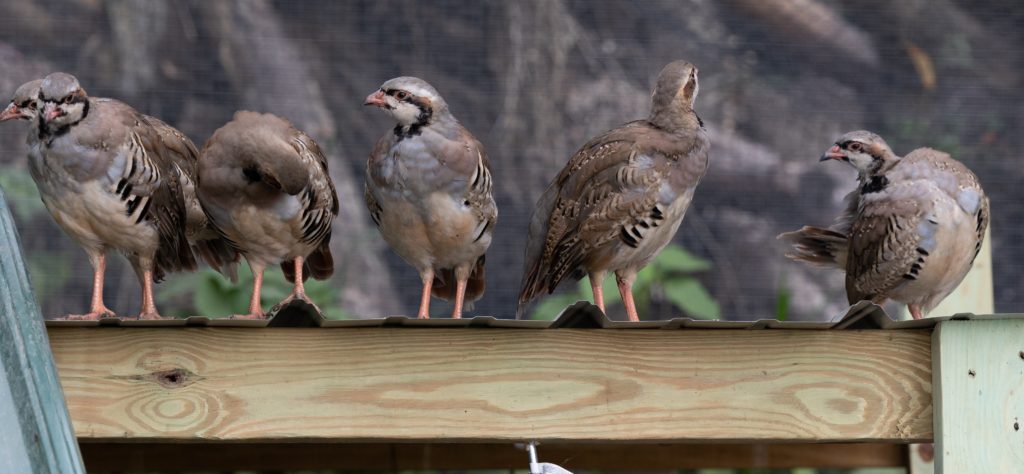
Introduction
This Resource Is Not Meant To Be A Comprehensive Treatment Of Chukar Care!
In this resource, we wish to provide caregivers with a general introduction to how chukars have come to need the care and attention of rescuers and farmed animal sanctuariesAnimal sanctuaries that primarily care for rescued animals that were farmed by humans., as well as some background on their history, social lives and behaviors in the wild to help assist caregivers with some basic necessary considerations in considering whether they should, and how they should care for chukars.
While they are not the most common species that your animal organization may encounter, chukar partridges in your region might find themselves in need of rescue and sanctuary! Like pigeons, peafowl and chickens, chukars have been carried around the world for human purposes. Of course, some of these purposes have included farming them for human consumption, and chukars are currently being marketed as a “gourmet food.” But probably the biggest purpose for which humans have used chukars is in “sport hunting.” This is the context from which most compassionate humans will encounter chukars in need.
Content Warning
The following paragraph of this resource discusses recreational violence towards chukars. For readers wishing to avoid this content, we recommend skipping the following paragraph.
Chukars are bred and raised en masse in captivity on game farmsFor-profit organizations focused on the production and sale of plant and/or animal products.. They are then released for “sport hunters” who employ trained dogs that track released chukars and “flush” them from their hiding places. The birds are then shot for recreation and consumption. Among some humans in the hunting community, chukars are considered to be ideal for training tracking and pointing dogs. This is because chukars have a proclivity to climb, run and fly away from potential threats. This makes them an “ideal bait bird” when it comes to “training” hunting dogs and an ideal “sport bird” when it comes to hunters, who like the challenge of shooting a “target” who is trying to escape them in a myriad of ways.
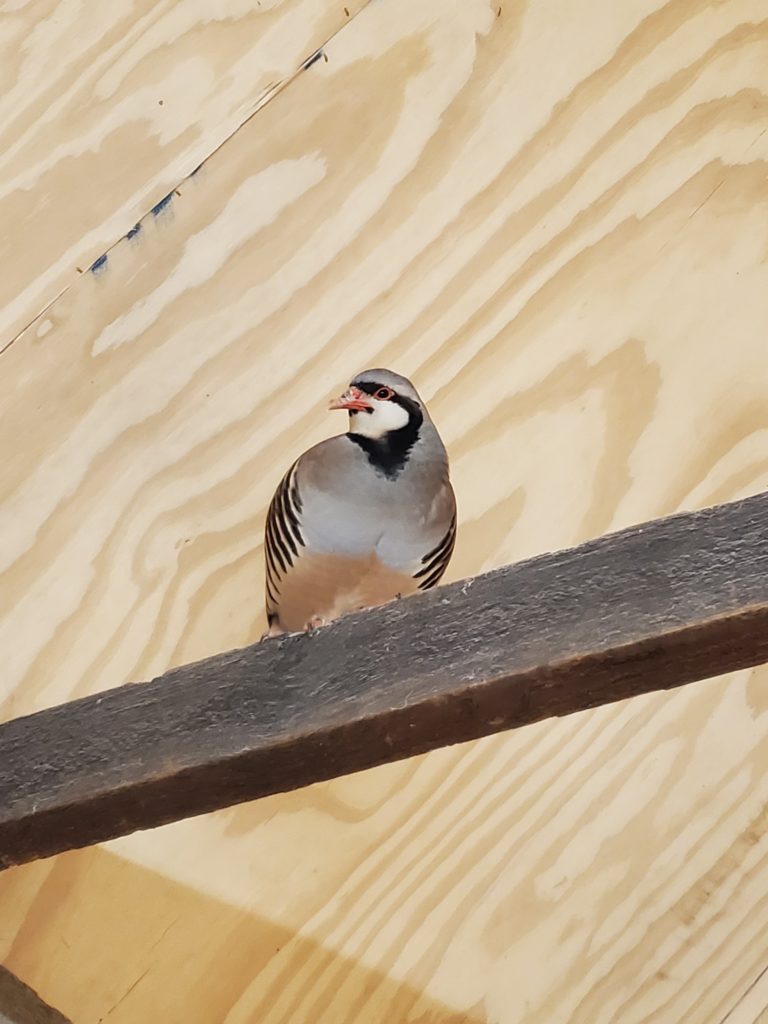
Of course, some chukars do escape breeders, game farms, and hunting grounds. And sometimes, humans introduce chukars to wild areas for the purpose of hunting them later. As a result, feral populations of chukars have established themselves in Canada, Mexico, New Zealand, and the United States, particularly in California, Washington, Oregon, Idaho, Hawaii, and the Rocky Mountain region. While some birds who escape or are introduced can thrive very well in the wild depending on the environment in which they have found themselves, this is not always the case. Birds who have lived long-term in confinement and captivity may require assistance and care after escaping from those conditions.
Additionally, as the ongoing backyard chicken trend continues to encompass more and more species of birds (such as peafowl, guinea fowl, and quails), you may even find stray chukars in urban areas. Unfortunately, chukars can fall into this situation based on how appealing they appear both size-wise and in terms of their appearance. Like other species of birds, chukars may be dumped after people who were attempting to keep them as “petsAnimals who spend regular time with humans in their home and life for companionship or human pleasure. Typically a small subset of animal species are considered to be pets by the general public.” or as “breeding stock” either allowed them to escape inadvertently or released them after realizing their care needs were beyond their capacity.
In all cases regarding chukars, it is important to remember that as endearing as they may appear, they are not as domesticated as birds like chickens or certain breeds of pigeons, for example. Therefore, chukars will not generally appreciate human contact and handling and should not be forced into interaction beyond what is necessary to do routine health checks and provide medical assistance as needed.
General Characteristics Of Chukars: Background For Caregivers
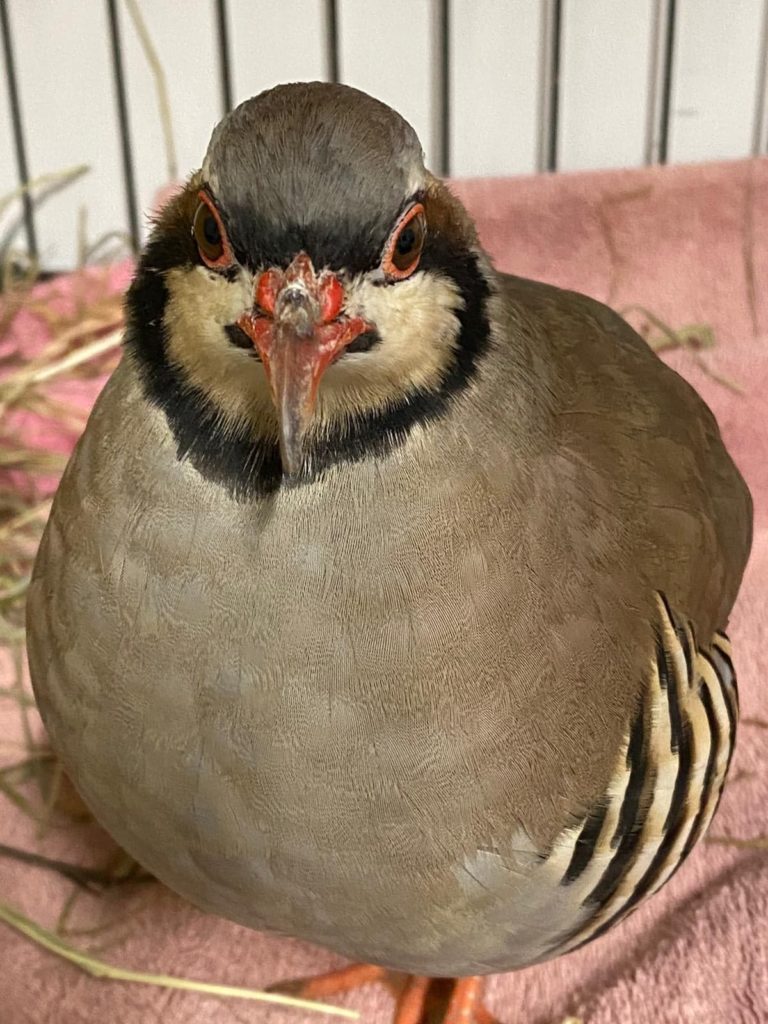
Understanding chukars’ natural environment, social behaviors in the wild, and diet can make a major difference in creating living environments that help these birds to thrive versus just surviving in a sanctuary context. So let’s start by discussing what a typical chukar habitat looks like!
The Natural Habitat And Habits Of Chukars
Chukars are in the same family as pheasants and are native to mountainous areas of the Middle East and Asia, with a range from eastern Greece to China. Chukars’ preferred natural habitats are largely arid, and the geography and landscape that they gravitate towards most are rocky hillsides, slopes, and walls. They find safety in vertical slopes and roost, forage, and nest in these areas.
Chukars also can be found in relatively open desert spaces with little vegetation, although largely, they prefer areas with brush that can provide them with nesting cover and shade. Although chukars tend to consume less water than many game birds and can even subsist off of water from small puddles, they prefer to congregate around a regular water source and, of course, require appropriate access to fresh water at all times.
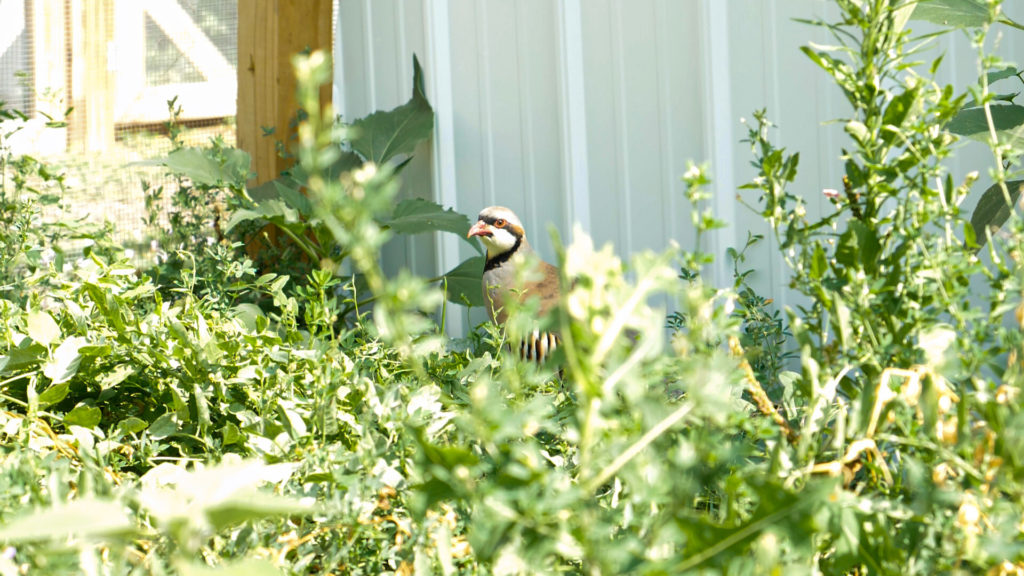
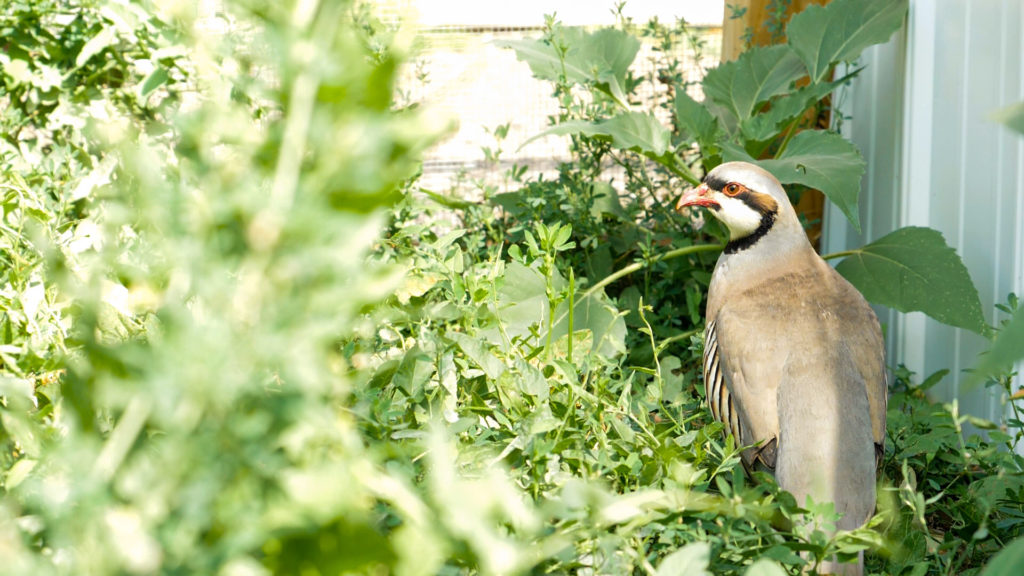
Starlet enjoys areas with heavy vegetation that provide cover and a feeling of safety. Photos courtesy of Mckenzee Griffler.
When snowy weather hits their habitat, they will migrate based on which altitudes are experiencing the most snow, moving away from higher elevations with more snow to lower ones with less snow. In cooler weather, they also prefer to find roosting spots on south-facing slopes, which are warmer. For caregivers, this means that, like most birds, chukars choose to avoid cold and snow. Therefore sanctuary housing for them should include measures for mitigating their exposure to extreme cold.
In terms of their habits, chukars like to feed and forage in the morning, and during the middle of the day, they will move to shade to relax, dust bathe, and seek water sources. As evening nears, chukars will move back to steeper areas for roosting, which provide them with greater protection from predation.
Despite being primarily ground-dwelling birds, chukars can fly well. Generally, chukars will choose to run instead of flying if they are frightened, but any chukar housing needs to account for their flight abilities. Aviaries should be netted and covered to prevent a startled chukar from flying off, as well as to protect them from winged predators. If you are called upon to rescue a chukar, remember the added complications associated with catching a fully flighted bird. If possible, attempt to catch them at night when they are asleep to conduct your rescue most effectively and with the least amount of trauma to the birds.
Therefore, to provide a chukar with a comfortable environment, it will be helpful to consider design from their standpoint. Predator proofing is critical to protecting these prey birds. Creating living spaces that incorporate vertical elements that chukars can climb and enjoy, including rocky elements like gravel piles, perennial vegetation elements that offer hiding places year-round, branches, and other options for getting up high, as well as protecting from the elements can help bring your chukar living spaceThe indoor or outdoor area where an animal resident lives, eats, and rests. to the next level!
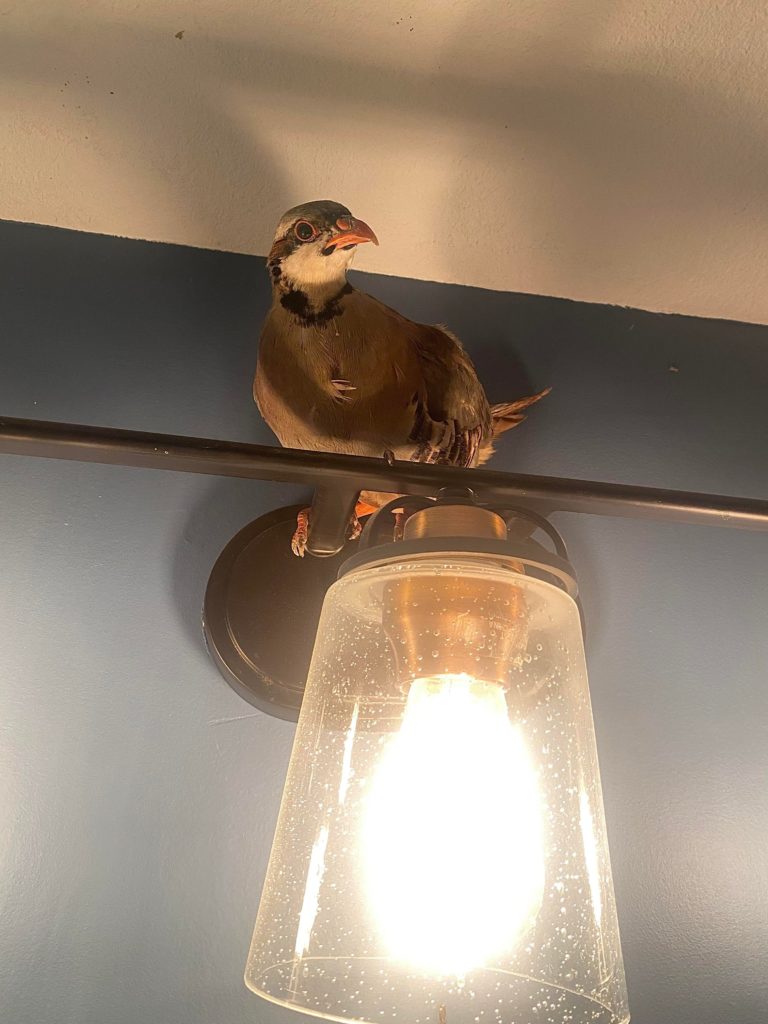
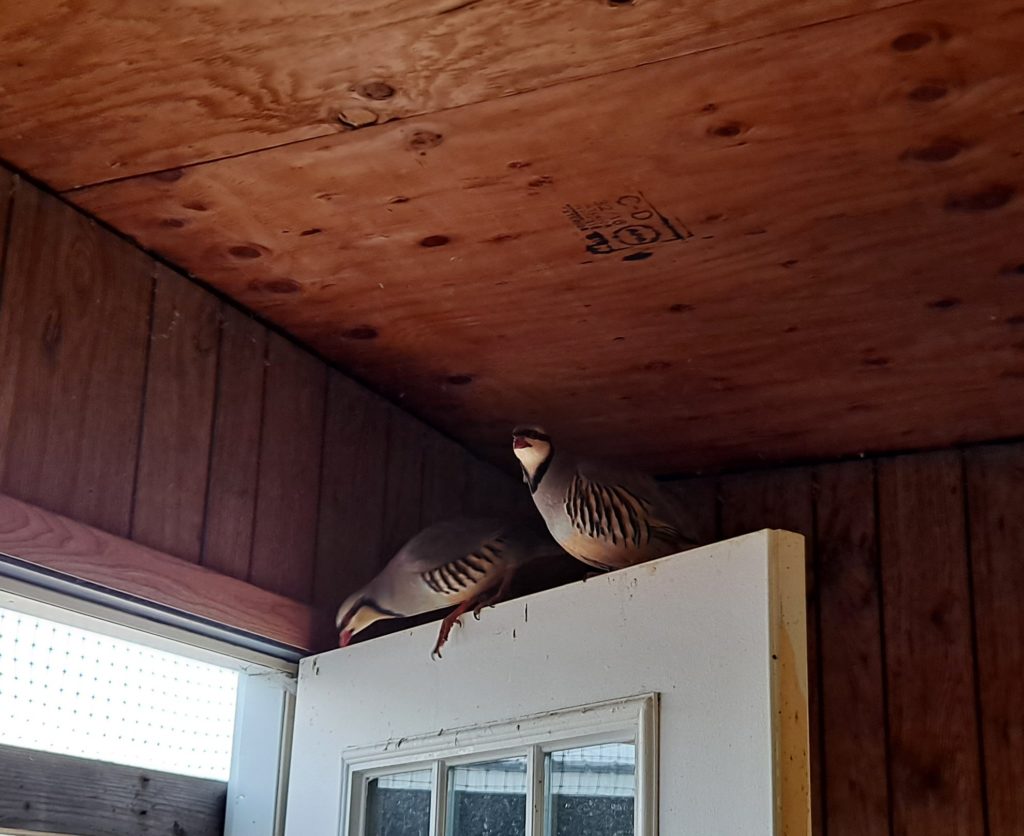
On the left Elle, who was quarantined in her caregiver’s bathroom after being found loose in downtown Columbus, Ohio, enjoys perching on high on a light fixture. Photo courtesy of Good Sprouts Sanctuary And Rescue. On the right, Jafar and Zazu enjoy exploring their living space from on high! Photo courtesy of Tiny Hooves Sanctuary.
Appearance And Differences Between Males And Females
Chukars measure around 14 to 15 inches in length. As prey animals, they have evolved distinctive markings and patterns that help to camouflage them in their natural habitats. Their backs and wings and bellies are grayish and brown. Their beaks, eyelids, feet, and legs range from pink to orange to red. They have white cheeks and a white throat which is circled by a black band. They sport black racing stripes on their sides. Chukars are extremely muscular and strong birds, and their claws and beaks are very sharp. As noted above, they are not domesticatedAdapted over time (as by selective breeding) from a wild or natural state to life in close association with and to the benefit of humans in the same ways that, for example, chickens are, and so they are largely averse to being handled by humans. Therefore we urge extreme caution when handling them to ensure both their safety and that of caregivers as well. If chukars must be caught and handled (as is necessary for routine health checks as well as when necessary to get them to veterinary visits), it may be best to do so at night after they have roosted, as chukars startle and become flighty very quickly, which can cause them and their caregivers injury.
Males and females do not have obvious differences in feathering, and so to an untrained eye, males and females look very much alike. It can be virtually impossible to determine whether juvenile chukars are male or female. But when it comes to adult birds, some slight differences can help you differentiate males from females.
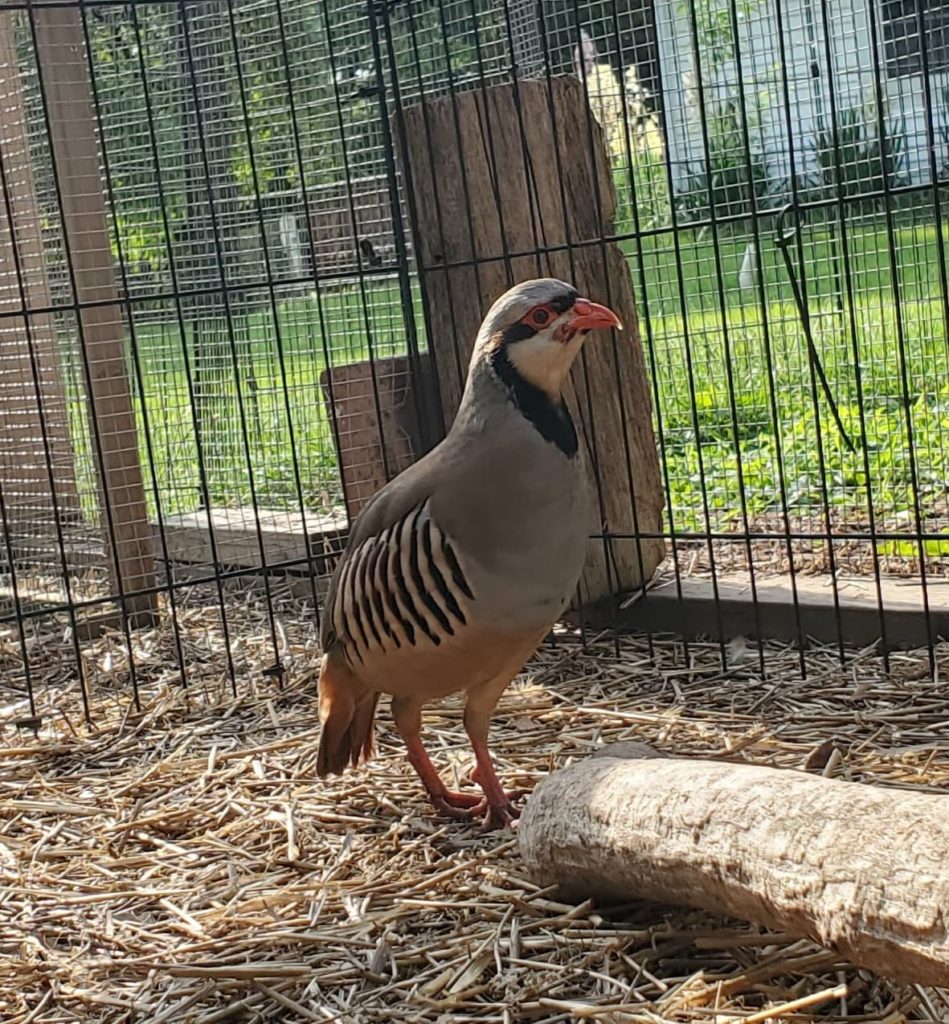
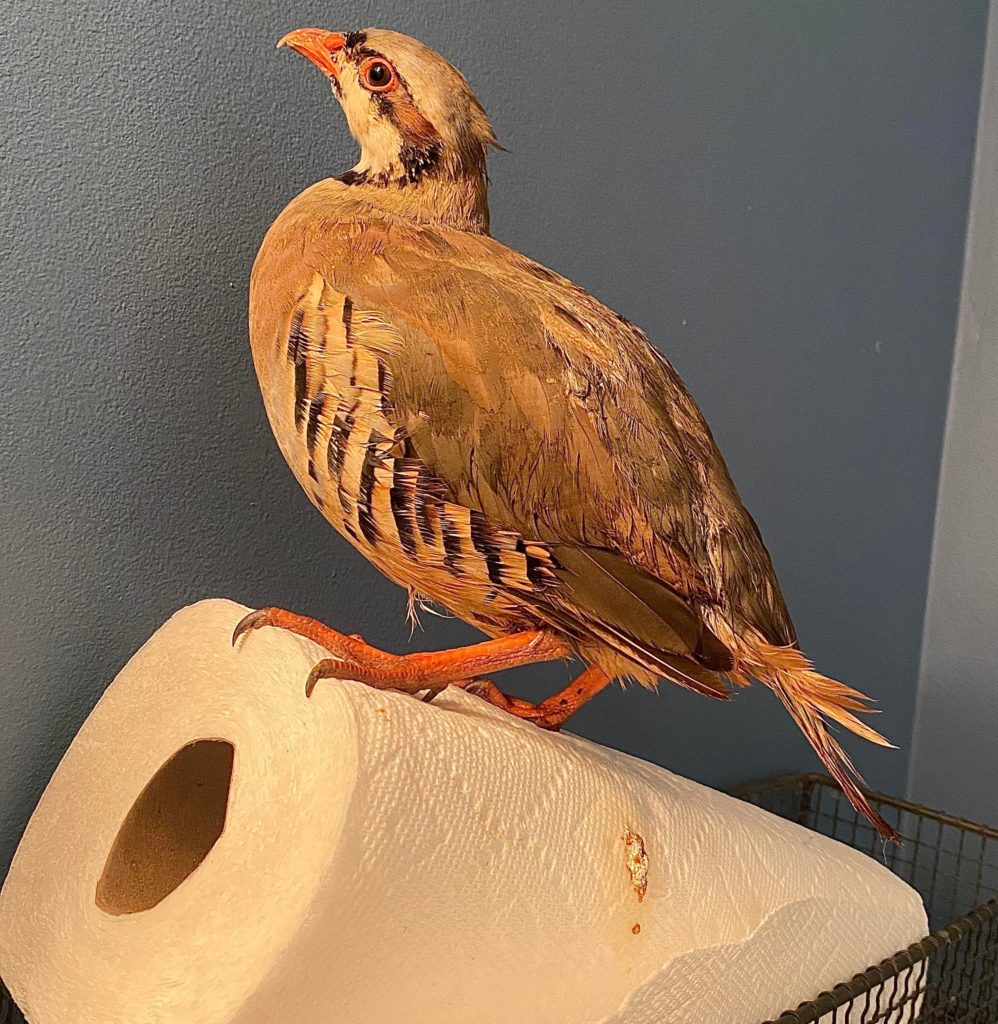
On the left, Chuckles, a male chukar, has a blocky head, and his beak is a vibrant red. Photo courtesy of Georgia’s Place Bird Sanctuary. On the right, Sarah, a female chukar. Note that Sarah’s beak is a less vibrant color than Chuckles’ beak, and she sports a spura stiff sharp spine (as on the wings or legs of a bird or insect) on her left leg. Photo courtesy of Good Sprout Rescue And Sanctuary.
Male chukars tend to be slightly larger, and the shape of their head is often blockier than those of females. The red of their beaks and legs may also be more vibrant than that of females. Additionally, some (but not all) female chukars will have a metatarsal spur. This is different from many bird species, where males have spurs! Please note that none of these factors are 100% determinative.
A surer way to tell is if you can examine the cloaca of the bird in question. Males will typically have a cone-shaped protuberance in their cloacal fold that is not present in females. This is easier to see in older birds. In contrast, females will either have no protuberances or may have two nodules off the center of the cloacal fold.
Given chukars’ general aversion to handling, and the fact that it may require some skill and experience to be able identify what you are looking for, it is a very good idea to consult with your veterinarian when it comes to sexing chukars. Ultimately the only sure way to tell the sex of a chukar is to have a blood test done by your veterinarian. We would recommend that you pursue this testing on intake, given that the question of cohabitating chukars with other avian species (as discussed below) may be impacted by the sex of the chukar.
The Social Lives Of Chukars
Being able to differentiate between male and female chukars is helpful because, as with many bird species, chukars typically exist in social groups, known as coveys. Coveys in the wild can number up to forty birds. Social dynamics between these birds can change based on whether it is breeding season or not. Outside of breeding season, chukars will band and travel together in coveys, but they form pairs in their breeding season and become less social. Males court females by showing off their racing stripes, doing circular dances, and by head-tilting. When a pair has formed and bonded, they will call to each other and offer each other choice food objects that they find, similar to how roosters “tidbit” for hens. At this time, males also become territorial and defend their spaces against other encroaching males. Keeping male chukars together has proved problematic for some sanctuaries due to this territorial behavior. It may be possible that male chukars can coexist with abundant space and a sufficiently enriching environment. Still, it is a factor that you should be aware of if you plan on providing sanctuary to them.
Chukars have a variety of vocalizations that they make to signal to each other and keep track of their partners, to warn of nearby predators, and that males make when other males encroach on territory during breeding season. They are best known for their characteristic “chuck chuck chuck” call, but they can also cackle, scream and make other sounds. Check out this site to hear some chukar songs! Note that while chukars are smaller birds, their vocal nature and their need for spacious habitats in which they can climb may make them less suitable for urban microsanctuariesMicrosanctuaries are small scale communities of human and nonhuman (generally “unconventional or farmed”) animal companions, who live together in a chosen shared lifestyle and in commitment to ending the oppression of all beings. Microsanctuaries adhere to the notion that no nonhuman member of the community should “serve a purpose.” Microsanctuaries can exist in any context: rural, suburban, or urban. A microsanctuary can consist of as small a community as one animal and one human caregiver. For more information on microsanctuary please refer to the Microsanctuary Resource Center., where space may be more limited.
In terms of nesting behavior, chukars build their nests on the ground. Females will choose a space under brush or hidden by rocks to create a depression in the ground, which they will line with grasses, leaves, and feathers. They can lay between eight and twenty eggs, which incubate within 22 to 24 days. The fact that chukars hide their nests on the ground like this is important to note for caregivers, who must keep an eye out for eggs to prevent any inadvertent breeding. Remember, because of the overwhelming need for so many animals to find refuge, sanctuaries shouldn’t allow residents to breed, either purposefully or accidentally.
Also, please note that even while chukars have not been domesticated in the same way that chickens have been, some sanctuaries have noted reproductive issues with their female chukar residents. This may be because birds who were raised in game farms in confinement were subjected to conditions (such as unnatural lighting) that may have caused them to lay more than they normally would. Therefore, monitoring female chukars for any issues in this regard is important, as well as consulting with veterinarians concerning reproductive care for them should it be deemed appropriate.
As a final note on the social lives of chukars, please note that despite their smaller size, they are very strong birds and, again, have not been domesticated in the ways that some other avian species have been. While they are social (as most birds are), they may have strong opinions about cohabiting with other species. Therefore you should take particular care in considering what avian residents you can safely house with chukars. Some sanctuaries have reported that male chukars have had conflicts with chicken residents, especially roosters, but have successfully integrated with larger bird residents such as turkeysUnless explicitly mentioned, we are referring to domesticated turkey breeds, not wild turkeys, who may have unique needs not covered by this resource.. However, also keep in mind chukars can be particularly susceptible to diseases such as blackhead, and so should be monitored and protected appropriately.
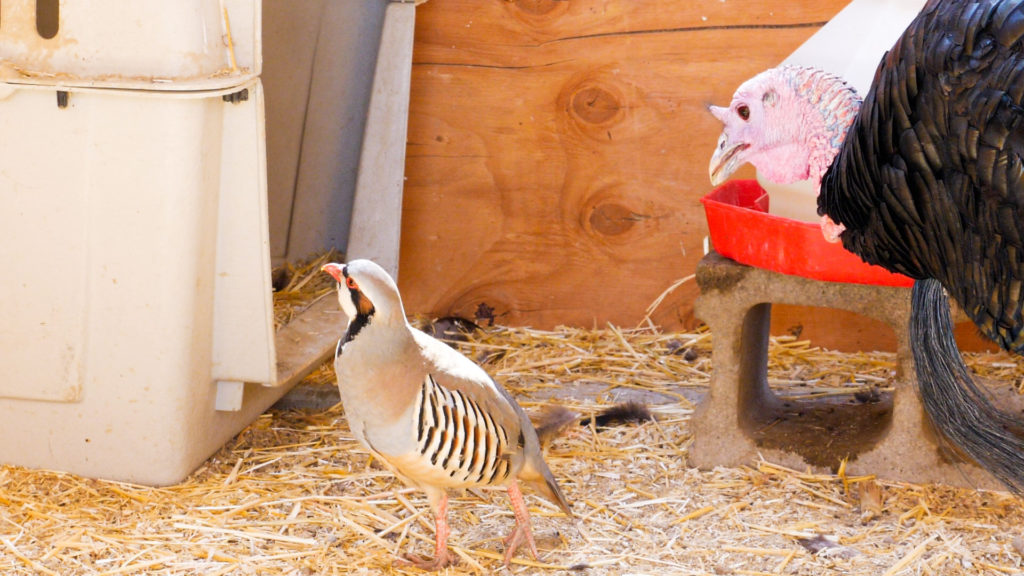
Chukar Diets
In their natural habitat, chukars’ diets will vary by season. Generally, they will forage for grains, seeds, forbs, and grasses and grass seeds when these are available. In winter, they may rely more heavily on seeds, while in summer, they seek out green leaves, insects, and will also climb into shrubs to eat berries.
Finding compassionate care guidance on chukar diets is difficult, as most chukars are raised for either human consumption (which may result in recommendations that result in a higher proportion of fat to lean tissue than is healthy for these birds) or for quick growth so that they can be released for sport shooters as soon after hatch as possible. There are commercial game bird foods available, and we recommend that you consult with your veterinarian on the most appropriate food for chukar residents depending on the individual’s age, sex, and health. We also recommend that you consider providing chukars with safe vegetation and sufficient space for exercise and foraging in their living spaces. In this way, these birds can enjoy browsing and consuming in a manner that is more aligned with their nature and habits in the wild. This is not only helpful to chukars in terms of providing them with a diverse diet but also in terms of providing them with an enriching life.
Conclusion
Understanding chukars’ native habitat, natural behavior, and their unique characteristics can help give caregivers some insight as to how to provide the kinds of environments in which chukars can thrive in a sanctuary setting. Specifically, caregivers of chukars should create housing that promotes lower humidity levels, provides multiple levels of elevation that chukars can explore, and sufficient year-round (and preferably consumable) vegetation under which the birds can seek cover. Chukars should also have protection from predators, snow, and cold. Special consideration should be taken when housing multiple male chukars together in terms of providing sufficient space, enrichment, and cover for them to escape one another, particularly in breeding season. Finally, if chukars are housed with other avian species, it is important to consistently and carefully monitor the interactions of all the birds to ensure that everyone remains comfortable and safe.
SOURCES:
Pigeons: How We Got Here | The Open Sanctuary Project
Peafowl: How We Got Here | The Open Sanctuary Project
Chickens: How We Got Here | The Open Sanctuary Project
Resident Drinking Water Considerations At Your Animal Sanctuary | The Open Sanctuary Project
The Care of Chicken Residents In Extreme Cold | The Open Sanctuary Project
Creating A Good Home For Chickens | The Open Sanctuary Project
Why Residents Shouldn’t Breed At A Farmed Animal SanctuaryAn animal sanctuary that primarily cares for rescued animals that were farmed by humans. | The Open Sanctuary Project
Suprelorin Implants | The Open Sanctuary Project
Time To Thrive: The Importance Of Enrichment | The Open Sanctuary Project
All About Birds: Chukars | The Cornell Lab
Chukar | Bird Web – Seattle Audubon Society
Chukar – Alectoris Chukar | NH PBS Nature Works
Chukar Sounds | The Cornell Lab
Raising Chukar Partridges | Cooperative Extension Division of Agricultural Sciences of the University of California (Non-Compassionate Source)
Non-Compassionate Source?
If a source includes the (Non-Compassionate Source) tag, it means that we do not endorse that particular source’s views about animals, even if some of their insights are valuable from a care perspective. See a more detailed explanation here.








